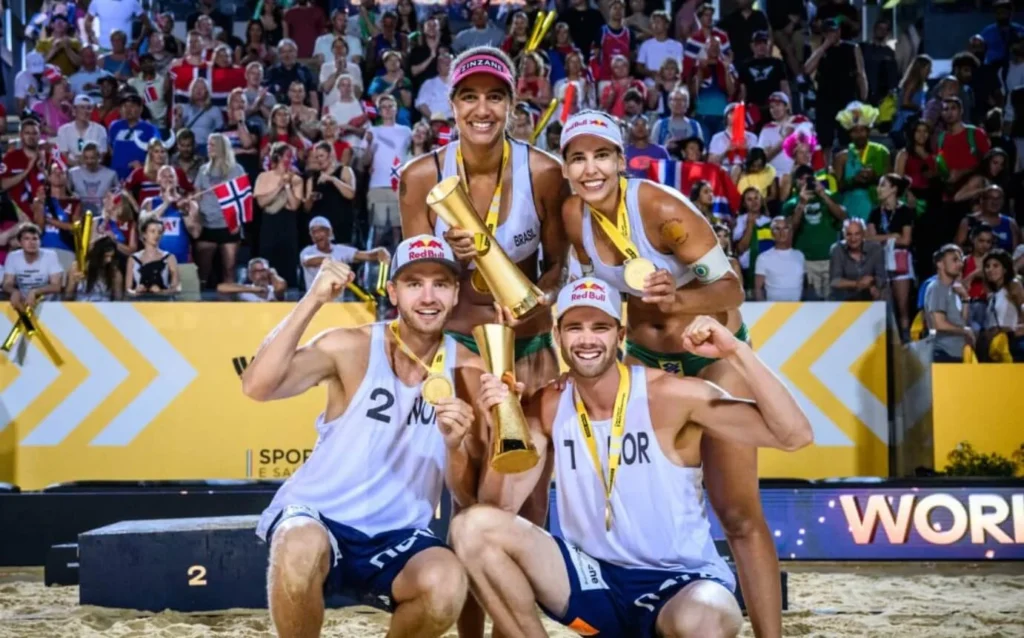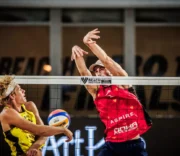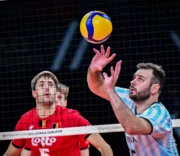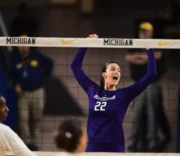
One of the year’s most eagerly awaited sports spectacles is upon us: the FIVB Beach Volleyball World Championships 2023. As athletes gear up and fans mark their calendars, the participating teams have finally been announced. This article takes you through the nuts and bolts of this eminent championship. We’ll examine everything from the teams to the unique aspects that make this edition special, including its structure, pathways for qualification, and more.
Host Cities and Dates: A Return to Latin America
Spanning from October 6 to 15, the World Championships will grace the terrains of Tlaxcala, Huamantla, and Apizaco. These Mexican cities are not just hosting a sports event; they are reviving a legacy. The championship returns to Latin America after a hiatus of 20 years, making the event even more special for the local populace and international fans alike.
A Closer Look at Qualification Paths
Understanding how teams get to participate can be just as fascinating as the event itself. Below are the distinct routes teams took to secure their spots.
Through FIVB Entry Points
Gaining FIVB Entry Points over the past six months was the most straightforward way to secure a position. 25 teams from each gender qualified in this manner, including a mandate that at least two teams must come from the host country, Mexico.
Table: FIVB Points Pathway
| Gender | Number of Teams via FIVB Points | Minimum from Mexico |
| Male | 25 | 2 |
| Female | 25 | 2 |
Continental Representation
Another 20 slots were filled based on continental quotas. These were divided as follows:
- CAVB (Africa): 4 spots
- AVC (Asia): 4 spots
- CEV (Europe): 4 spots
- CSV (South America): 4 spots
Wildcard Entrants
Lastly, three wildcard entries per gender added a dash of unpredictability and excitement to the championships.
Global Diversity: A Melting Pot of Talent
The World Championships will be a showcase of global talent, featuring 40 different nations.
Breakdown of Participating Countries
- Europe: 16
- NORCECA region: 9
- South America: 6
- Asia: 5
- Africa: 4
Brazil leads the pack with nine teams, followed by the United States, Mexico, Australia, Germany, Italy, and the Netherlands.
Men’s Division: A Potpourri of Skill and Ambition
The men’s category promises a thrilling contest. Five out of the six teams that clinched medals at the Rome 2022 World Championships are returning. Notably, reigning men’s Olympic champions Anders Mol and Christian Sørum of Norway declared, “The Beach Volley Vikings will try to become the first men’s team to win back-to-back editions of the tournament.”
Up-and-Comers and Time-Tested Veterans
Fresh faces such as Sweden’s David Åhman/Jonatan Hellvig and the Netherlands’ Yorick De Groot will be partaking in the competition. On the other end of the spectrum, stalwarts like Pablo Herrera of Spain and Pedro Solberg of Brazil bring in years of experience. The latter mentioned, “I have played in every edition since 2007, except for 2022.”
Women’s Field: Where Skill Meets Tenacity
The women’s category is equally electrifying, featuring the formidable Brazilian duo of Eduarda ‘Duda’ Lisboa and Ana Patrícia Ramos, the reigning champions.
Partner Switches and Long-Awaited Returns
An interesting development is the return of last year’s silver medalist, Canadian Brandie Wilkerson, but with a new teammate—Melissa Humana-Paredes. Also, the comeback of American Olympic champion Alix Klineman has been stirring interest.
Championship Format: From Pools to Podium
After understanding the historical context and the competitive landscape, it’s crucial to dive into the nitty-gritty: the championship format that guides teams from the initial pool matches all the way to the coveted podium finishes.
The Initial Rounds: Pool Dynamics
In the first phase, teams will be allocated to 12 different pools consisting of four teams each. They will face off in a round-robin style to qualify for the subsequent rounds.
The Final Stages: Knockout Battles
Once the pool rounds are completed, the competition moves into a single-elimination format, commencing with the Round of 32.

A Stroll Down Memory Lane: The Historical Significance of the FIVB Beach Volleyball World Championships
As we gear up for the 2023 edition, it’s worth taking a look back at the tournament’s rich history. The FIVB Beach Volleyball World Championships have evolved into a pinnacle event for the sport, where athletes get the rare chance to represent their countries in a highly competitive setting.
The Genesis: Humble Beginnings
The inaugural tournament took place in 1997, and since then, it has grown exponentially in scope and reach. The first events were relatively modest affairs, with the volleyball community still getting to grips with the logistics and protocols of a world championship. Yet, they laid the groundwork for what has now become a marquee event in the international sporting calendar.
Milestone Events: Olympic Consideration and Beyond
One of the most pivotal moments in the championship’s history was its role in helping beach volleyball gain Olympic recognition. The consistent growth and widespread interest in the world championships over the years helped elevate the sport’s status. As a result, beach volleyball made its Olympic debut at the 1996 Atlanta Games—a year before the inaugural world championships.
Memorable Champions: Records and Rivalries
Over the years, the championships have given us unforgettable moments and exceptional champions. Brazil and the United States have been particularly dominant, with their athletes often setting records and achieving ‘firsts.’ For instance, the legendary Brazilian duo of Emanuel Rego and Ricardo Santos won a record three world championships together.
Women’s Feats: Breaking the Mould
The women’s category has also witnessed extraordinary performances, becoming a platform for athletes to shatter stereotypes and break barriers. In the early 2000s, Misty May-Treanor and Kerri Walsh Jennings of the United States became a household name, with their triumphs showcasing the dramatic growth and allure of women’s beach volleyball on a global stage.
Recent Developments: The Road to 2023
The last decade has seen increasing diversification in terms of winning nations, signifying the global growth of the sport. Teams from Europe, like the Dutch and the Norwegians, and even from Australia, have started to make their presence felt. As the 2023 championships approach, the question on everyone’s minds is whether the traditional powerhouses will maintain their dominance or if new contenders will rise to the occasion.































